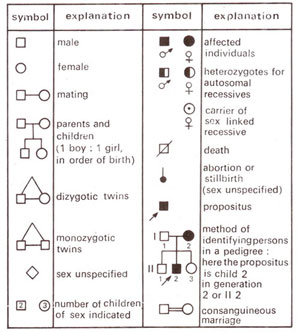
Fig. 2.13. Symbols used in human pedigree analysis.

Fig. 2.14. A pedigree involving an exceptional phenotype controlled by recessive allele V (gene symbols are generally not given in pedigrees; they are given here as aid to the readers; redrawn from Suzuki et al., 1986).

Fig. 2.15. A pedigree involving a rare phenotype controlled by a dominant allele VT (redrawn from Suzuki et al., 1986) symbols are generally not given in pedigrees; they are given here as aid to the readers; redrawn from Suzuki et al., 1986).
In the above discussion, we utilized the examples of pea as used by Mendel for explaining various aspects of
particulate inheritance. However, the application of Mendel's laws for a study of
problems of heredity in humans will be most interesting, yet it is most difficult for the following reasons (besides others) : (i) controlled crosses cannot be made, (ii) duration required for a study of three generations will be long (several decades). In view of the above, human geneticists often scrutinize family histories (pedigrees) in the hope that informative matings might have occurred by chance. This is called
pedigree analysis. A member of a family having an exceptional phenotype (e.g. colour blind or deaf or dwarf), which first attracts the attention of a geneticist, is called
propositus. The history of the exceptional character in the propositus is traced back in the family and a family tree is prepared using standard symbols (Fig. 2.13).

Fig. 2.13. Symbols used in human pedigree analysis.
Many human diseases or defects are governed by simple genes. Common examples of these traits include albino, Tay-Sachs disease, cystic fibrosis, phenylketonuria (PKU), etc. Following generalizations can be made : (i) a recessive character may appear in the progeny of both unaffected parents; (ii) two affected parents cannot have an unaffected child; (iii) often these characters appear among children born from consanguineous marriages (e.g. first cousin marriage), which enhance the chances of mating among two heterozygotes for the same recessive trait. This also explains why often consanguineous marriages (or sagotra marriages among boy and girl from same gotra-ancestry) are forbidden in several castes in our country. A typical pedigree for a rare recessive condition is shown in Figure 2.14.

Fig. 2.14. A pedigree involving an exceptional phenotype controlled by recessive allele V (gene symbols are generally not given in pedigrees; they are given here as aid to the readers; redrawn from Suzuki et al., 1986).
Rarely, the exceptional character may be governed by dominant alleles (e.g. Huntington's chorea; brachydactyly—very short fingers). This situation will be characterized by the following : (i) the condition occurs in every generation; (ii) unaffected parents can never transmit the condition to the offspring; (iii) two affected parents may have unaffected children; (iv) condition is passed on, on an average, to one half of the children of an affected individual. A typical pedigree of a rare dominant condition is shown in Figure 2.15. The pedigree analysis as above, helps in the identification of genes and gives information about the mode of its inheritance. The medical applications of such a genetic analysis, obviously, are far reaching. This information is particularly useful in day-to-day counseling of prospective parents, who fear genetic disease in their children. A more detailed account of human genetics is given in
Human Genetics.

Fig. 2.15. A pedigree involving a rare phenotype controlled by a dominant allele VT (redrawn from Suzuki et al., 1986) symbols are generally not given in pedigrees; they are given here as aid to the readers; redrawn from Suzuki et al., 1986).








